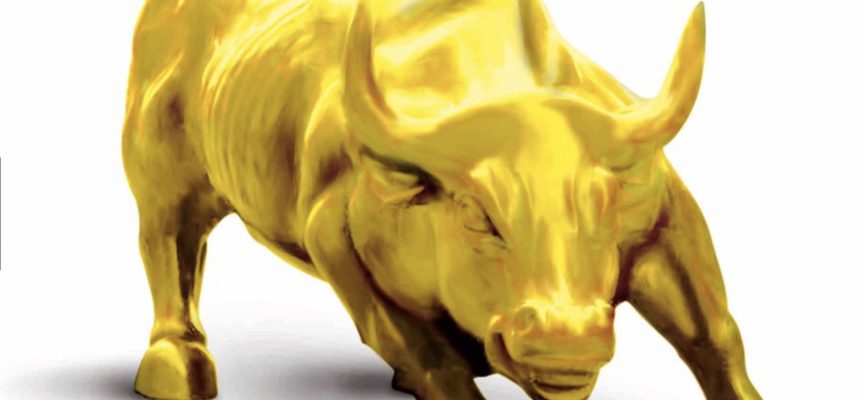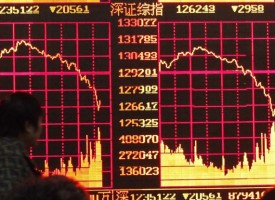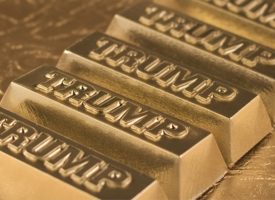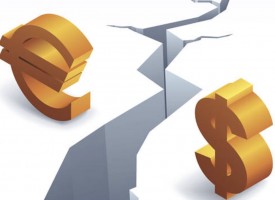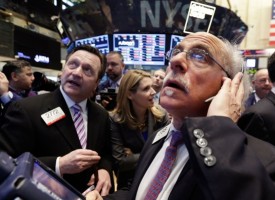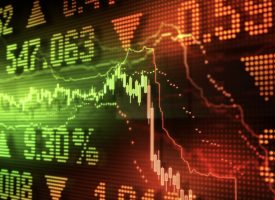With stock markets trading higher and the US Dollar Index attempting to hold the key psychological level of 90, today a legend in the business sent King World News a powerful piece stating the gold price is set to spike nearly $1,000.
Gold’s Price Set To Soar
By John Ing, Maison Placements
March 29 (King World News) – As if the world economy isn’t fragile enough, it appears that we are on the brink of a trade and currency war, compounded by a protectionist reversal of globalization that could sink the dollar which already has lost its traditional safe haven appeal. As the United States inflames relations with China and Japan, it risks a retaliation that could cause fearful investors to dump dollars and seek refuge in yen, euros and gold. Stock markets around the world plunged on fears of an old fashioned “tit-for-tat” trade war, evoking dark memories of the Smoot-Howley Tariff Act of 1930 that exacerbated the Great Depression, when global trade collapsed under a 40 percent duty increase. Ironically that disaster was the genesis for more liberalized trade,with America one of the chief architects. Yet politicians never seem to learn from history.
Start with trade, in 2002 President Bush slapped a 30 percent tariff on steel imports, causing the market to drop 30 percent sending the US dollar lower but only 21 months later, reversed those tariffs to avoid a trade war with Japan and Europe. Today, although the US imports four times as much steel as they export, Trump called for a trade war, declaring them “easy to win” and then imposed a global tariff on steel and aluminum imports affecting some 100 countries. Ironically, China sends less than 2 percent of its steel to the US. Risky as well is the expected defensive reaction to America’s new found economic nationalism, in the form of a “beggar thy neighbour” stance where every country turns to protect their own national interest. The omens are bad. History shows that trade wars are bad and impossible to win.
Of concern is that this confluence of events echoes the blunders of the 1930s. And, with inflationary pressures already stalking the market, we believe the trade moves will further fan the inflationary fires, increasing a growing trade deficit. This move on tariffs has already triggered the resignation of Trump’s economic czar, Gary Cohn who thought the levies would kill jobs, blunt economic growth and further marginalize the United States. And with the firing of Tillerson, Trump’s anti-trade advisors are on the ascendance, undermining the very rules-based trading system America helped create over seventy years ago.
American Economic Hegemony Is Changing
Yet the market thinks it is different this time. At the core of this argument is a basic misunderstanding of the role of trade. There is no zero-sum equation. Currencies are the key and the supply is controlled by the cartel of central banks. In the US, the Fed controls the supply of dollars. Recently the US dollar has slipped on concerns that Trump’s budget and trade policies would add up to a weaker greenback and change in an American world order. Moreover, Trump is set to become the biggest spender since the Depression.
In the Sixties, President Johnson introduced deficit spending to finance his Great Society program as well as pay for the Vietnam War. Yet, US debt to GDP was only 30 percent then and America was a creditor nation. However, that bout of money printing caused the Great Inflation which flirted with hyperinflation until Fed Chairman Paul Volcker drastically cut back money supply, sending interest rates to double digit levels. In the Eighties, Ronald Reagan introduced the Tax Reform Act of 1986, which saw supply-siders predict tax cuts would stimulate growth. Instead inflation soared and the US dollar collapsed as foreign lenders realized Mr. Reagan was debasing the very currency they held. In 1988, the Plaza Accord was signed, which devalued the dollar to reduce America’s current account deficit. Ironically, only two years later Japan emerged even stronger, giving way to the Louvre Accord to halt a subsequent 40 percent slide in the dollar.
Gold, the classic hedge against inflation, was the best performing asset, increasing 1,500 percent in a 20-year run from $32 an ounce to over $500 an ounce. Today, what is different is that the debt burdens are much higher with debt to US GDP over 100 percent and, America’s spending is much higher. The common denominator of then and today? The persistent rise in the supply of money. It is not so different this time. Gold is set for its next bull run.
China Has Many Levers to Pull
Importantly, there appears to be a sea-change in the relationship between Washington and Beijing. Washington views China as a “strategic competitor” citing China’s exports and trade policy as threats to America’s economic future. This change has several ominous dimensions. Tariffs was America’s first volley as the White House hopes to cut the annual trade deficit by $100 billion by slapping a whopping $60 billion of tariffs on Chinese goods. China’s initial response to the salvo was levying only $3 billion of tariffs on American imports. So it begins. China also offered to loosen investment rules and purchase American semi-conductors, even after US blocked earlier moves. Yet China has many levers to pull.
First is financial. China is the world’s largest external holder of US debt holding some $3.1 trillion of foreign exchange reserves with more than $1 trillion in US debt despite selling in December and January. China’s large US treasury holding is only one of the levers and the People’s Bank of China (PBOC) has already been publicly quoted as seeking alternatives to the dollar. China is the world’s largest oil importer and has swapped oil for gold, becoming the world’s largest trader in physical gold. China has even begun trading in oil futures in another step towards more financial independence from the dollar.
Second, China is the world largest exporter and the slapping of some $60 billion of tariffs on Chinese products could see wider and more damaging Chinese tariffs on Boeing airplanes, Harley Davidsons, American wine, soybeans or wheat. Consumer electronics, such as Apple products to which American consumers have developed a voracious appetite, unwittingly would become more expensive in a “tit for tat” war, as well as face a potential Chinese boycott on US goods.
Third, China has internationalized the renminbi and purchased gold with its mammoth reserves to lessen the dollar’s hegemony. For over a century, Britain led global trade until its economy was devastated by World War I and eventually became so weak financially that they were forced to abandon the gold standard, causing the American dollar to replace Britain’s pound. Ironically, the US too was forced to end the dollar’s linkage to gold in 1971 under the financial strain of the Vietnam War and Lyndon Johnson’s Great Society. Subsequently, the dollar became a fiat currency allowing the US to accumulate debt on a horrific scale. In fact, the Federal Reserve deserves a share of the blame since its inflationary policies have priced out American goods from global trade, resulting in the trade deficits that so angers Mr. Trump.
China is The Lender of Last Resort
From multi-billion bond-buying programs, to supply side economics, to negative rates, to fighting two wars with deficit spending, to trillion dollar tax cuts, the Fed experimented with extreme Keynesian measures to keep the economy going, only to rack up more debt. By debt financing its deficits, the United States has become the world’s largest debtor with an astonishing $21 trillion in debt, doubling since the Fed began its QE experiment ten years ago. America itself is a bubble, particularly disturbing to those countries who are creditors of the United States. With America mired in deficits and the dollar losing influence, we believe a new monetary regime is in the making, primarily because China, the world’s largest creditor has become the lender of last resort.
Looking to China though is problematic. Not only is China considered a strategic economic rival, but lately the United States has restricted Chinese investments and technology, vetoing the purchase of a small stock exchange and a semiconductor testing company and of course, firing the first shot in a potential trade war. The dilemma for America is how to safeguard domestic industries, court Chinese investments and trade with Beijing at the same time. Mr. Trump has already taken a hardline stance, undermining the rules based system in which America was one of the key architects. Meantime, the Chinese government takeover of indebted Anbang sees the Chinese now owning chunks of American real estate. Other conglomerates like Dalian Wanda, HNA and Fosun also own chunks of US businesses. While hotels are not strategic, the growth of protectionism and the escalating risk of a protectionist trade war with the United States makes the task of financing America’s prolificacy increasingly difficult. Is it different this time?
How Will America Fund Its Deficits?
America’s economic hegemony is undermined by its growing deficits and debt load. The overvalued dollar and this huge mountain of debt is one of the most vulnerable pillars of global stability and America’s Achilles’ heel. Wikipedia says that, “hyperinflation occurs when a country experiences very high and usually accelerating rates of inflation, rapidly eroding the real value of currency….. hyperinflation sees a rapid and continuing increase in nominal prices, the nominal cost of goods and in the supply of money”. Since 2008, money supply has increased at 6 percent whilst US GDP has only grown by 1.42 percent. So much money, so few results. So far the imbalance between the supply and demand for money has shown up in the stock market, hard assets and classic cars, as too much money chased too few goods.
However, in the last few months, labor markets have tightened, inflation has burst through the two percent level and commodities are at five-year highs. At this time, the central banks should be tightening. The dilemma for central bankers is that they have piled up a mountain of high-powered money reserves whilst their governments have racked up more deficits and debt. A core principle it seems is that there is no restriction to debt issuances. Price or interest rates seem to the key. Amid the recent pickup in activity and velocity, Mr. Trump has added to the problem with self- inflicted wounds, from trillion dollar tax cuts to very expensive infrastructure plans made more expensive by his tariffs. Further, his ill-suited trade policies could spark a trade war, which would have inflationary implications. Perhaps the self described “king of debt”, with a decades long real estate background, push for an inflationary agenda, is really a mechanism to ease America’s debt burden.
In the interim, someone must lend America the money to fill their outsized deficit gap. More money printing? Unlikely given the market vigilantes. America is to discover that it will be increasingly difficult to attract flows of the magnitude needed, particularly when Trump erects more trade barriers on its creditors who have financed over half of its debts.
What Are Friends For?
At one time, economists envisioned that Asia and the Americas would one day join in a single deal so large that would span the globe. That dream is still a dream but it appears that there are now competing visions between the West and the East with the likelihood of Asia replacing the US-led global economic order. There is nothing dreamy about Donald Trump in making “America first”. Trump’s erection of trade barriers is based upon a belief that competition will be won by winning a bilateral trade fight that he has already lost, mainly because of America’s propensity to consume more than they produce.
China has become a rising economic superpower with a huge savings surplus and in Trump’s words, a “strategic competitor”. However in scrapping America’s long-standing commitment to liberal trade and globalism under Trumponomics, China has displaced it in importance, cementing deals with many of America’s trading partners with the result being a dramatic increase in China- led export growth. China has emerged as the global trading engine and the world’s largest exporter, necessary to keep the economy of 1.4 billion people growing.
In reshaping its institutions, mercantilist China is enjoying a growing economy allowing it to spread its wealth and influence, rebuild its military strength and unlike the West, possess a single- minded and now, leadership for life. China is even needed to reverse North Korea’s nuclear program. Notwithstanding the US imposition of tariffs, China’s reaction has been fairly muted, even possibly strategic. That is unlikely to last. Trump’s broadside firing at China’s steel industry missed its mark with collateral damage to trading partners, Canada and Brazil who are the largest exporter of steel to the US. China stopped shipping to the US for that very reason. Moreover while the Trump administration is eyeing limits on Chinese investments, a trading relationship worth some $630 billion is at risk and no one will emerge unscathed. In fact, as Canada discovered, everyone suffers.
The Chinese have been adept at capitalizing on the vacuum created. For example, the 11 nation Trans-Pacific Trade deal (TPP) which was conceived and constructed by the United States and quickly scrapped by Trump, will reshape trade in the East, without America’s input. China’s leader, President Xi created the Asian International Infrastructure Bank (AIIB), that rivals the World Bank. Rather than bailout the entire financial infrastructure as the US did during the subprime crisis in 2008, Beijing seized control of Anbang and arrested its Chairman, which once held assets of $310 billion (no executive was jailed after the 2008 Wall Street collapse). And while Obama and Trump were trading barbs, China unveiled the $1 trillion One Belt, One Road initiative linking some 70 countries with rails, bridges and roads from China to Africa to Europe and even Latin America. This geopolitical initiative is many times larger than the Marshall Plan created over seventy years ago to revive Europe’s war ravaged economies that cemented America’s global influence. Citigroup, HSBC and Standard Chartered lined up for a piece of the action despite lukewarm support from the West.
Is it Different This Time?
While this president has blown up the federal debt with trillion dollar deficits, scrapped trade agreements and left his party behind on gun control and free trade, once the sacred cows of his Republican party, how can Mr. Trump finance his “America First” agenda?
We are at crossroads. Inflation embers are aglow, the US has turned more protectionist, Brexit threatens Europe, Italy the world’s largest eighth economy is beset by populism, and an Italian exit from the EU looms. In the Middle East, the Iran nuclear deal may be scrapped. America’s debt chickens are coming home to roost and a buyer’s strike of US debt is in the offing. We are now at the beginning of the end of the long bull run and the beginning of an inflationary storm that will not end well.
Although we are a long way from the “Dirty Thirties”, we believe that recent events will teach foreign investors that there is no longer easy money to make by shipping funds by the boatload to the world of Wall Street and leave them in the hands of their particularly discredited practitioners. America’s deficits can no longer be financed by this inflow of funds. We have been here before.
Gold Set To Spike Nearly $1,000 As Fear Stalks World
We thus believe gold will continue to rise in value as long as Americans are unwilling to boost savings, consume more than they produce and expect others to finance their current account and trade deficits. Ironically, this president is good for gold. Gold will be a good thing to have while so much fear stalks the world. We continue to expect gold to reach $2,200 an ounce within 18 months. In the near term, $1,375 remains resistance.
Why I Bought 400,000 Shares Of This Gold Exploration Company
A 17-Bagger In Gold?
Eric King: “I’m a shareholder (purchased 400,000 shares so far in the open market) of your company (symbol TORQ in Canada and TRBMF in the US). I know the insiders have been buying as well and can’t seem to get enough of this stock. You guys are not in this for a double or a triple. When I see you guys (insiders) buying this aggressively (over 2.5 million shares of insider purchases recently), you’re looking to make 5X or 10X your money.”
Michael Kosowan, CEO (insider): “You are right, we don’t look at making 20% or 30%. The large insider shareholdings means that we are really looking to monetize to a larger entity. Our vision is to build these assets and get to over $10 a share (roughly 17X higher than the current price of 65 cents!)…To learn more about which gold exploration company insiders have been buying like crazy CLICK HERE!
***Also Just Released MAJOR ALERT: Legend Says Violent Back And Forth Prelude To Massive Surge CLICK HERE.
© 2018 by King World News®. All Rights Reserved. This material may not be published, broadcast, rewritten, or redistributed. However, linking directly to the articles is permitted and encouraged.

